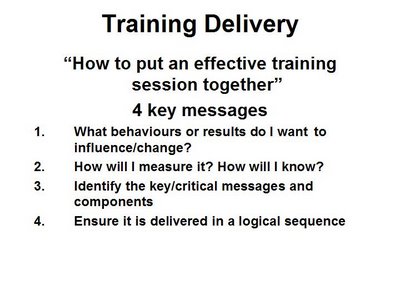Saturday, December 09, 2006
Six Paradigms of Human Interaction
I have just been having a look at Dr Stephen R Covey's book - The 7 Habits Of Highly Effective People (again) and in particular the above section, which I thought was worth sharing with you.
- Win/Win - and I quote - "Is a frame of mind and heart that constantly seeks mutual benefit in all human interaction. Win/Win means that agreements or solutions are mutually beneficial and mutually satisfying."
- Win/Lose - "In leadership style, Win/Lose is the authoritarian approach: " I get my way, you don't get yours." Win/Lose people tend to use their position, power, credentitals or personality to get their way.
- Lose/Win - "Maybe worse than Win/Lose because it has no standards, no demands or expectations or vision." Lose/Win is usually used by people who are eager to please or appease. They seek strength from popularity or acceptance (probably Lose/Win will be evidenced more in Amiables and possibly Expressives rather than Drivers and Analyticals - see previous postings). Lose/Win people bury a lot of feelings, and unexpressed feelings never die. They may manifest themselves later in ugly ways. People who are constantly repressing, rather than transcending feelings towards a higher meaning find that it affects the quality of their self esteem and subsequently the quality of their relationships with others."
- Lose/Lose - "When two Win/Lose people interact, the usual result will be Lose/Lose Both will lose." Dr Covey quotes an example of a particualrly acrimonious divorce case where the husband was directed to sell his assets and turn over 50% of the proceeds to his ex-wife. So he sold his $10,000 car for $50 and gave $25 to his wife! When his ex-wife protested the judge discovered that he was doing the same with all his other assets!
- Win - People with the Win mentality don't necessarily want others to lose, they just want their own way and will leave it up to others to get theirs.
Which of these five is best? Well it does rather depend doesn't it?
You can't play a football match with a Win/Win mentality can you?
Often companies have incentives and prizes which means someone wins and someone loses.
If you value a relationship and the issue is not that important you may go for Lose/Win in some circumstances to genuinely affirm the other person.
Sometimes you would just want to Win. If, for example, there was a natural disater and your child's life was in danger, you would be concerned about the other people who may be at risk, but saving your child would be your sole aim.
"The best choice." says Covey "depends on reality. "The challenge is to read that reality correctly and not to translate Win/Lose or other scripting into every situation."
"Most situations are part of an interdependent reality and then Win/Win is really the only viable alternative of the five."
The sixth option is:
- Win/Win or No Deal - "which basically means that if we cannot find a solution that would benefit us both, we agree to disagree, agreeably."
Extract from The 7 Habits Of Highly Effective People by Dr Stephen R Covey
Posted by Hugh at 9:41 am 0 comments
Friday, December 08, 2006
Measuring Impact Of Your Training
Assessment or Evaluation?
Training has 2 key parts:
1. The quality of the training that has taken place. Have the participants enjoyed it? What excercises were used? What was the quality of the venue like? The quality of these can be assessed by completing questionnaires and talking and listening to the participants feedback.
2. And more importantly, the quality and value of what people have learnt as a result of the intervention. What learning has taken place? Have the people changed as a result and what will they will do differently that will be of personal benefit to them in terms of their own behaviour and performance and what does it mean to the bottom line of the organisation. The value of these can be evaluated.
Posted by Hugh at 7:09 pm 0 comments Labels: Learning and Development
Sunday, November 05, 2006
Social Styles - Some snippets
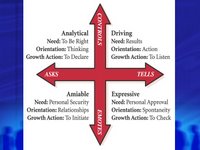 Someone who is perceived as "Tell" Assertive would be seen as "More" Assertive and someone who was "Ask" Assertive would be seen as "Less" Assertive.
Someone who is perceived as "Tell" Assertive would be seen as "More" Assertive and someone who was "Ask" Assertive would be seen as "Less" Assertive.Posted by Hugh at 7:23 pm 0 comments Labels: Learning and Development
Thursday, November 02, 2006
Nick's Grammar Slammer (Part 2)
Along with Eats, Shoots and Leaves - this is great!
Possessives
The ending 's is used to indicate the singular possessive of any word that does not end in s:
President Bush's victory
The monkey's nuts.
For the possessive of singular words that end in s, the traditional rule is to use 's:
Pythagoras's principle
Mr Jones's letter.
However, some writers now adopt a more streamlined approach and prefer a bare apostrophe for all words ending in s. For example:
Jacques Delors' limousine
Boris' faux-pas.
Note that the possessive form of it does not take an apostrophe - in fact, the only personal possessive pronoun with an apostrophe is one's.
The dog was chasing its tail.
Use a bare apostrophe for regular plural possessives:
The families' cars
The doctors' conference.
For irregular plurals, use 's:
The men's room
Sheep's eyes.
Elision
The apostrophe is also used to indicate that part of a word (or words) is missing. Examples are I've, didn't, can't, it's and doesn't.
Plurals
Never use apostrophes to make a plural.
Not three book's but three books
Not six MP's but six MPs
Not the 1990's but the 1990s.
However, some people argue that apostrophised plurals should be allowed where they make the meaning clearer. For example, how would you write p's and q's, or do's and don'ts? But as a general rule, the grocer's plural is unmatched in its power to undermine the credibility of both message and writer.
Contributor: Jane Smith & Nick Smith
Posted by Hugh at 8:48 pm 0 comments Labels: Learning and Development
Gorillas and Bananas
The Gorillas and the Bananas Story
An experiment was conducted with four gorillas who were moved into the same cage. When the gorillas were first introduced into the environment, the experimenters would lower bananas into the centre of the cage. When the gorillas went after the food, all were hosed down with a high-pressure water hose. Even if only one went after the food, all received the same treatment.
As expected, soon the gorillas did not go after the bananas when they were lowered into the cage. Behaviour was trained and reinforced.
Now, the experimenters replaced one of the gorillas.
When the bananas were lowered into the cage, the new gorilla, of course, started toward the free meal. The other three gorillas knew what would happen, so they quickly jumped the new gorilla, keeping him from causing the dreaded response of water,
Although perplexed, the new gorilla quickly learned not to go after the food lowered into the cage, and to jump any other gorilla that did the same.
The experimenters continued by slowing replacing each gorilla one by one. The result was the same: the new one went for the food the others jumped him.
Soon the experimenters had replaced all of the four original gorillas. Keep in mind that the high-pressure water hose had not been used since the first four gorillas were together. But every time a new gorilla went for the food lowered into the cage, the others stopped him cold.
The experimenters were able to go several generations away from the original four gorillas, but still the behaviour did not change. None of the gorillas knew why they shouldn’t go for the food, but they knew what to do if any one did. It was what was done before them, and before them, and so on. A proud tradition was born.
You ever heard the response when some one asks "Why did you do that?"......
"That's the way we do things round here."
Lesson: Behaviour is learned
Acknowledgement - Stuart Emmett
Posted by Hugh at 8:11 pm 1 comments Labels: General Stuff
Thursday, October 26, 2006
The Change Curve
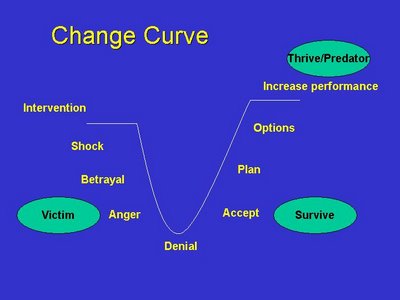 Too often "The Dungeon of Denial" is where people tend to dwell when going through a difficult period of change.
Too often "The Dungeon of Denial" is where people tend to dwell when going through a difficult period of change.
Have you ever challenged someone when they are in denial?
What is the usual response?
"No I am not!"
Posted by Hugh at 4:50 pm 0 comments Labels: Learning and Development
Monday, October 23, 2006
Some Thoughts On Leadership
Click here>>>>>Some Thoughts On Leadership
Short video 1m 15secs
Posted by Hugh at 12:38 pm 0 comments Labels: videos
Scott's View On Icebreakers
Click here>>>>>Why Icebreakers Are Not A Good Idea
Very good short message. Make the icebreaker relevant and something that your audience can use right away!!
Posted by Hugh at 12:28 pm 0 comments Labels: videos
Saturday, October 21, 2006
Situational Leadership II Mind Map
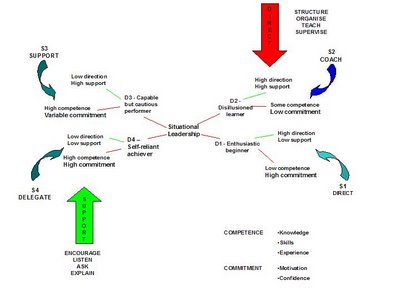 For those of you who have studied Situational Leadership, here is a Mind Map of the key areas to remember. The Development Levels - D1 to D4. The Leadership Styles S2 to S4 and the descriptors of the levels of Competence and Commitment in each Development Level.
For those of you who have studied Situational Leadership, here is a Mind Map of the key areas to remember. The Development Levels - D1 to D4. The Leadership Styles S2 to S4 and the descriptors of the levels of Competence and Commitment in each Development Level.Posted by Hugh at 3:57 pm 0 comments Labels: Learning and Development
Training Delivery
Begin with the end in mind. What behaviours or results do you want to influence or change?
What processes and measures will you put in place to confirm the success of the training?
Ensure that it is delivered in a logical sequence. Think about your audience and remember the saying "I hear - I forget. I see - I remember. I do - I understand." You will have a mixture of learning styles within your audience, therefore it makes sense to integrate a variety of learning delivery to accommodate those styles.
Too much theory may put off the Pragmatists* (who prefer to learn when there is a link between the subject and implementing on the job)) and Activists* (those who prefer to try new and different things. They like action based learning). Launching people straight into role-plays and getting them involved in the "doing" with minimal input may not be the best way of engaging the Theorists* (who need to explore and test theories before implementation. They are rational and logical) and Reflectors* (who prefer to observe first and think about what they have learned before application).
Think about your audience in respect of their "Readiness" for the the training. Where are they in relation to their Competence - (Knowledge, Skill and Relevant Experience) and Commitment - (Confidence and Motivation)?
Have you linked the training to your diary and is it relevant to what is happening now in the business?
Posted by Hugh at 9:54 am 0 comments Labels: Learning and Development
Thursday, October 12, 2006
Active Listening (courtesy Anne Marie Sheridan)
Active Listening:
You can actively listen by using the following:
Non-verbal noises:
Allow the speaker to know that you are really listening to what they are together with the appropriate facial expression – a smile for example, head movement, body posture. The skilled use of these ‘hmm’ ah oh uhh can encourage the speaker to speak indefinitely
Supportive statements
These are the verbal equivalent of non-verbal noises. These are ways of saying ‘I’m with you’… keep going.
You can also use listening questions to support the speaker… can you give me an example? It seems as though?
Key word repetition
If you really are listening these can be picked up and can be used to encourage the speaker
Reflective statements
This is used to help the speaker see that you are with them and that you want to add on to what they have said. The most usual form of reflection is expressed as a statement and tends to begin with ‘you feel that…?’ ‘it seems to me that?’ These words indicate to the speaker that you are interpreting the emotional undertones of what is being said – and you are putting your finger on the deeper emotions behind the words and showing a real understanding of speaker’s feelings.
Physically demonstrate that you are listening:
This shows the speaker that you are ‘with’ them. Consider how you feel if you are talking to someone and they appear to be half asleep… who don’t look like they are listening. The trick in attending physically is to let people see that you are listening.
Posted by Hugh at 7:41 pm 1 comments Labels: Learning and Development
Lovely Sunset (taken with Finepix F410)
Posted by Hugh at 11:34 am 0 comments Labels: Photos
Surely I am not like him!
Recently for a laugh, I completed a free online character profile and this is who I came up as! Honest, it must be wrong!!
Posted by Hugh at 11:18 am 0 comments
How is your General Knowledge? 1 point for each correct answer.
1. Which kind of dancer was Mr. Bojangles?
2. Which William featured as a team captain in Question Of Sport?
3. Where did William III defeat a French army in 1690?
4. What does hydrogen combine with to form water?
5. Where in The House of Lords do peers with no party loyalties sit?
6. What is the northernmost point of the British Mainland?
7. Which branch of medical science is concerned with muscle?
8. Which actor’s real name was Reginald Carey?
9. Prince George of Denmark was the husband of which English Queen?
10. What was the true vocation of the detective in the stories by G. K. Chesterton?
11. Which TV programme has Judith Harn & Carol Vorderman presented?
12. Who was the first woman elected to the British Parliament?
13. Where on the human body is the skin the thinnest?
14. Which French writer lived with the composer Chopin?
15. On what day in 1939 did Britain declare war on Germany?
16. Which advertiser said “We care because you do”?
17. What is the most abundant gas in the atmosphere?
18. Whose real name is Bernard Schwarz?
19. What did the “D” stand for in Franklin D Roosevelt?
20. Who bought Elizabeth II her first corgi?
See Comment for answers! How did you do?
Posted by Hugh at 1:56 am 1 comments
Wednesday, October 11, 2006
PREPARE
This involves preparation in terms of:
· Any materials required
· Identification of the development need
· The coach’s understanding of the behavioural changes required
EXPLAIN
The coach needs to explain in detail the behaviours that they are about to demonstrate in “Show”. The objective is to give the individual a clear understanding of the behaviours they have to change prior to seeing the demonstration
SHOW
The coach demonstrates the skill required as explained
OBSERVE
The individual attempts to replicate the demonstration they have observed. The coach makes notes for use during feedback
SUPERVISE/SUPPORT
The coach provides feedback on how the individual’s performance compares to the explanation and the demonstration given. The objective is to build the individual’s confidence and where appropriate give ideas for improvement
There is a limit to how much can be explained and shown in one go. Break the behaviour in to component parts as necessary.
Posted by Hugh at 11:05 pm 0 comments

Selling Isn't Telling. It is all about turning needs into wants. It is about understanding what the needs and preferences of your customer are and then turning those needs into wants and making sure that you either make them money, save them money or improve their life by your recommendation. You do that by asking questions, checking understanding, ensuring that the customer knows that you understand. Making sure that you really do understand. By seeking and giving feedback. Trial closing. Inviting questions. (APIAC) Acknowledging concerns, Probing to understand, Isolating that concern ("If we can resolve this issue, is there anything else that would prevent you from buying this product/service today?"). Answering their concern (to their full satisfaction) then Confirming the purchase with the customer (closing the sale).
Posted by Hugh at 1:49 am 0 comments
The Indispensable Man - A litttle reminder for those who think they are!
Sometime when you’re feeling important,
Sometime when your ego’s in bloom,
Sometime when you’re feeling quite certain,
You’re the best qualified in the room.
Sometime when you feel that your going,
Would leave an unfillable hole,
Just follow this simple instruction
And see how it humbles your soul.
Take a bucket and fill it with water,
Put your hand in it up to the wrist,
Take it out and the hole that’s remaining
Is the measure of how you’ll be missed.
Posted by Hugh at 1:01 am 0 comments
Tuesday, October 10, 2006
Leadership Quotes
Having the power to get things done My Way, the captain’s way, can be exhilarating, and seductive. It is also terribly limiting. It limits the team to being the reflection of the one in charge. ~ Jim Thompson, Shooting in the Dark
Anyone can become angry – that is easy. But to be angry with the right person, to the right degree, at the right time, for the right purpose, and in the right way – this is not easy. ~ Aristotle
God grant me the serenity to accept the people I cannot change, the courage to change the one I can, and the wisdom to know it's me. ~ Author Unknown
Individual commitment to a group effort: this is what makes a team work, a company work, a society work, and a civilisation work. ~ Vince Lombardi, Former Green Bay Packers Coach
Simply doing more of what worked in the past - will be too incremental. More than that, it will be too slow. The winners of the future will be those who can develop a culture that allows them to move faster, communicate more clearly, and involve everyone in a focused effort to serve more demanding customers. ~ Jack Welch, General Electric Company
Blessed are the flexible, for they shall not be bent out of shape. ~ Michael McGriff, M.D.
There is only one time that is important – NOW! It is the most important time because it is the only time that we have any power.” ~ Leo Tolstoy
Far better it is to dare mighty things, to win glorious triumphs, even though chequered by failure, than to take rank with those poor spirits who neither enjoy much nor suffer much, because they live in the grey twilight that knows not victory nor defeat. ~ Theodore Roosevelt
Excellence is doing ordinary things extraordinarily well. ~ John W. Gardner
Dependent people need others to get what they want. Independent people can get what they want through their own efforts. Interdependent people combine their own efforts with the efforts of others to achieve their greatest success. ~ Stephen Covey
The best executive is the one who has sense enough to pick good men to do what he wants done, and self-restraint to keep from meddling with them while they do it. ~ Theodore Roosevelt
A leader is best when people barely know he exists, not so good when people obey and acclaim him, worse when they despise him. But of a good leader who talks little when his work is done, his aim fulfilled, they will say: We did it ourselves. ~ Lao-Tzu
The boss drives people; the leader coaches them. The boss depends on authority; the leader on good-will. The boss inspires fear; the leader inspires enthusiasm. The boss says "I"; The leader says "WE". The boss fixes the blame for the breakdown; the leader fixes the breakdown. The boss says, "GO"; the leader says lets, "GO!" ~ H. Gordon Selfridge
Too many managers don’t realise that when you become truly participative, you get into a lot of uncomfortable conversations in which you hear things about the situation and about yourself that you might not like. ~ Peter B. Vaill, Managing as a Performing Art
One of the true tests of leadership is the ability to recognise a problem before it becomes an emergency. ~ Arnold Glasow
Posted by Hugh at 10:09 pm 0 comments
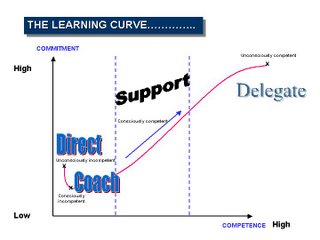
The Learning Curve: I use this model extensively when working on Leadership Development and delivering the principles of Situational Leadership. The measures are Commitment & Competence and the four key points in the journey towards competence are: Unconsciously Incompetent (you don't know what you don't know): Consciously Incompetent (The light switch has gone on! You realise you are not as good at this as you thought!): Consciously Competent (You have to think about what you are doing): Unconsciously Competent (The task has become second nature to you).
You will notice that at each point the leadership style needs to change. At the first point on the learning curve (Unconscious Incompetence), you need to be Directed, given clear instructions, shown what to do and when and closely monitored and supervised.
At the second point, when you realise that you are not as good as you think you are (Conscious Incompetence), the Leadership style needs to change slightly with less tell and more asking questions.
As the Leader, you would still own the task or goal and the responsibility for helping the follower to climb the learning curve. Here you would provide high direction, but your supportive behaviour would increase , this is known as Coaching style.
As competence increases to Conscious Competence, the direction diminishes and the Support increases. Eventually you become Unconsciously Competent and are able to perform the task with little or no supervision. Here the Leadership style changes to Delegating, which provides low direction and low support and allows the self reliant person to get on with the task.
One of the dangers is of course slipping back into Unconscious Incompetence.
Think about these 4 stages as learning to drive a car.
How many of you would pass your driving test if you had to take it again tomorrow morning at 9 a.m.? Not many I would imagine, as you have (and I have), picked up some bad driving habits along the way. Might it not be the same with everyday tasks we perform at work and at home?
Posted by Hugh at 7:32 pm 0 comments
Training:
Training refers to the acquisition of knowledge, skills, and competencies as a result of the teaching of vocational or practical skills and knowledge that relates to specific useful skills. It forms the core of apprenticeships and provides the backbone of content at technical colleges and polytechnics. Today it is often referred to as professional development.
Physical training is more mechanistic: planned suites of regimes develop specific skills or muscles with a view to peaking at a particular time. A specialized field of training often used in sports is autogenic training. Another type of training is fartlek training which is a flexible training type which can be adapted to suit almost any athlete.
Many early American astronauts trained extensively in Iceland's central highlands due to its similarity to an extraterrestrial planet.
Training & Development is the field concerned with workplace learning to improve performance. Such training can be generally categorized as on-the-job or off-the-job. On-the-job describes training that is given in a normal working situation, using the actual tools, equipment, documents or materials that they will use when fully trained. On-the-job training is usually most effective for vocational work. Off-the-job training takes place away from normal work situation which means that the employee is not regarded as productive worker when training is taking place. An advantage of off-the-job training is that it allows people to get away from work and totally concentrate on the training being given. This is most effective for training concepts and ideas.
In military use, training means gaining the physical ability to perform and survive in combat, and learning the many skills needed in a time of war. These include how to use a variety of weapons, outdoor survival skills, and how to survive capture by the enemy, among others. See military education and training.
In religious and spiritual use, training means purifying mind, heart, understanding and actions to obtain a variety of spiritual goals such as closeness to God or freedom from suffering. Typical of institutionalized spiritual trainings is the Buddhist Threefold Training.
Retrieved from "http://en.wikipedia.org/wiki/Training"
Categories: Training Education
Posted by Hugh at 7:28 pm 0 comments
Leadership Development:
In organizational development, leadership development is the strategic investment in, and utilization of, the human capital within the organization.
David Day (2001) distinguished between leader versus leadership development.
Leader development focuses on the development of the leader, such as the personal attributes desired in a leader, desired ways of behaving, ways of thinking or feeling.
In contrast, leadership development focuses on the development of leadership as a process. This will include the social influence process and the team dynamics between the leader and his/her team at the dyad level, the contextual factors surrounding the team such as the perception of the organizational climate and the social network linkages between the team and other groups in the organization.
Both forms of development may mutually influence each other, as exemplified in the concept of "Deep Change" in Robert E. Quinn's 1996 book of the same title.
Typically, leader development has focused on 3 main areas - providing the opportunities for development, stimulating the ability to develop (including motivation, skills and knowledge for change), and providing a supportive context for change to occur (see Cynthia D. McCauley, 2001).
Leadership development can build on the development of individuals (including followers) to become leaders. In addition, it also needs to focus on the interpersonal linkages between the individuals in the team.
In the belief that the most important resource that an organization possesses is the people that comprise the organization, some organizations address the development of these resources (even including the leadership).
Leadership development can encompass any number of developmental processes including:
talent identification and management
individual development planning
management development
360-degree feedback
succession planning
mentoring
coaching
Conflict Style Inventory
[edit]
References
David V. Day (2001). Leadership Development: A review in context. The Leadership Quarterly, 11, 581-614.
Cynthia D. McCauley(2001). Leader training and development. In The nature of organizational leadership. San Francisco: Jossey-Bass.
Robert E. Quinn (1996). Deep change: Discovering the leader within. San Francisco, CA: Jossey-Bass.
[edit]
External links
Conscious Leadership
Leadership Simulator
Carter McNamara's Free Online Library
Governance Focus issues in governance worldwide, in English & Español
Leadership Development WIKI
Retrieved from "http://en.wikipedia.org/wiki/Leadership_development"
Posted by Hugh at 7:18 pm 3 comments
Kenneth Blanchard is an American businessman, as well as a consultant, speaker, trainer, and author on management and leadership.
He owns the Ken Blanchard Companies, a family-owned business in San Diego, California, and is well-known for developing the Blanchard and Hersey Model of situational leadership theory, together with Paul Hersey. He and others have extended it as Situational Leadership® II. With Spencer Johnson, he developed the One Minute Manager concept, and co-authored a series of books on it. His One Minute Manager Library has collectively sold more than 7 million copies and has been translated into more than 20 languages. He has also tied in Situational Leadership with team development, which he calls Highly Performing Teams.
Dr. Blanchard received his B.A. from Cornell University in government and philosophy, an M.A. from Colgate University in sociology and counseling, and a Ph.D. from Cornell in educational administration and leadership. He maintains a faculty position as Professor of Leadership and Organizational Behavior at the University of Massachusetts Amherst and a visiting lectureship at Cornell University, where he is also an elected member of the Board of Trustees.
He has been a guest on a number of national television programs, and has been featured in Time, People, US News & World Report.
Contents[hide]
1 Works
2 In Education
3 References
4 External links
Posted by Hugh at 6:54 pm 0 comments
Friday, October 06, 2006
A Nasty Internet Experience! Beware of SpyNoMore.com
On Sunday, 1st October my PC was infected with a virus which took over my home page and slowed my computer down considerably.
I did a Yahoo search to find the best spyware remover and was led to SpyNoMore. They offered a free scan of your computer but you had to pay for the removal of the spyware. The scan revealed 84 infections! I bought a 3 machine licence (I have 2 laptops as well as the PC) for $39.95 + tax.
When I paid SpyNoMore sent me a registration number to activate the download and to remove the offending viruses. Unfortunately when I entered the registration number I got the message "Invalid Receipt Number". I contacted their Help Desk over the Internet and within a couple of hours got a message to tell me to uninstall the programme and then reinstall it and all would be fine. Hmmm! Not so. I did as they asked and got the same message.
I tried 5 times altogether and still received the same message. I did get one further message from the Help Desk basically telling me to do the same again. Since then, I have sent a further 6 or 7 messages asking for help and have not had one reply!
So anyone who reads this I would strongly urge you not to be fooled by SpyNoMore. They are charlatans! I have also complained to Clickbank who authorised the payment and they have replied and said that they have no record of such payment, yet my bank statement clearly indicates that it went through them.
Be warned DO NOT PURCHASE SPYNOMORE!!!
Posted by Hugh at 4:12 pm 0 comments
Saturday, September 16, 2006
What I find really cool about behavioural styles, people styles, social styles or call them what you will. is the fact that you can measure it on just two dimensions of behaviour. The horizontal arrow denotes Assertiveness, which is the degree to which a person will try to influence others. So someone to the left of the vertical arrow will influence by asking and the person to the right, by telling. The vertical line denotes Responsiveness, which is the degree to which a person responds to another emotionally. So a person above the horizontal line would appear to be "cooler" and have their emotions in check, whereas someone below the line would be "warmer" and perceived as more people oriented. By observing behaviour on these two dimensions you come up with the 4 styles. If you would like to find out more, post a comment and I will do a bit more on it. I find it fascinating and, if you know what you know then you can modify your behaviour to accommodate others to have a more productive and rewarding interaction with them!
Posted by Hugh at 5:25 pm 0 comments
Friday, September 15, 2006
Hi everyone
I work as an independent training and business consultant, specialising in Behavioural Change and Leadership. I am doing a lot of work at present with colleges of further education in the UK. I help people to recognise their own particular style and that of people they work with. This enables them to modify their own behaviour when dealing with others. I also train and coach the principles of Situational Leadership which is inspired by the Leadership and One Minute Manager series.
When the link between individual styles and leadership is established, it fosters a much more productive working relationship. It increases the value that we place on ourselves and our co workers. It reduces tension in relationships and helps us to better understand ourselves and our fellow human beings.
Behaviour is learned - and "What we learn, we learn by doing." - Aristotle
Posted by Hugh at 5:00 pm 0 comments


